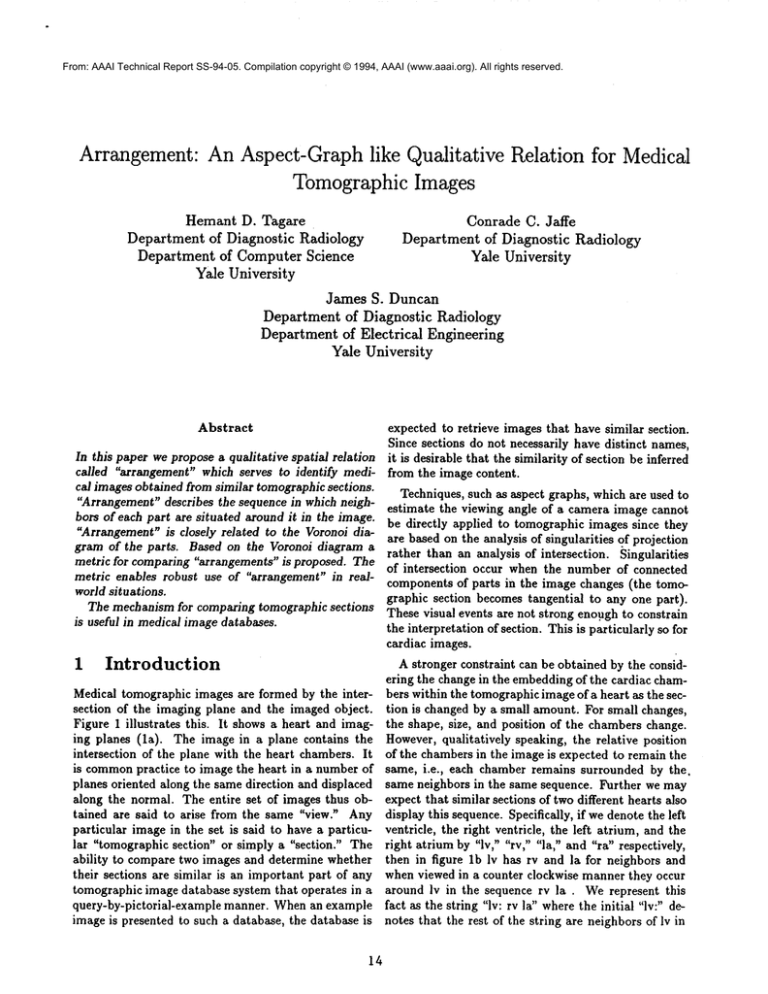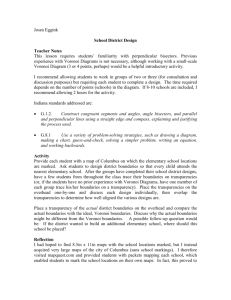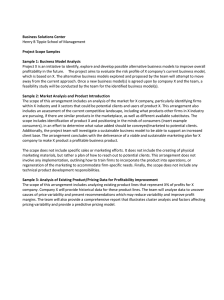
From: AAAI Technical Report SS-94-05. Compilation copyright © 1994, AAAI (www.aaai.org). All rights reserved.
Arrangement"
AnAspect-Graphlike Qualitative Relation for Medical
TomographicImages
Hemant D. Tagare
Department of Diagnostic
Radiology
Department
of Computer Science
Yale University
Department
Conrade C. Jaffe
of Diagnostic
Radiology
Yale University
James S. Duncan
Department of Diagnostic
Radiology
Department of Electrical
Engineering
Yale University
Abstract
In this paper we propose a qualitative spatial relation
called "arrangement" which serves to identify medical images obtained from similar tomographic sections.
"Arrangement" describes the sequence in which neighbors of each part are situated around it in the image.
"Arrangement" is closely related to the Voronoi diagram of the parts. Based on the Voronoi diagram a
metric for comparing "arrangements" is proposed. The
metric enables robust use of "arrangement" in reMworld situations.
The mechanism for comparing tomographic sections
is useful in medical image databases.
1
Introduction
Medical tomographic images are formed by the intersection of the imaging plane and the imaged object.
Figure 1 illustrates
this. It shows a heart and imaging planes (la). The image in a plane contains the
intersection of the plane with the heart chambers. It
is commonpractice to image the heart in a number of
planes oriented along the same direction and displaced
along the normal. The entire set of images thus obtained are said to arise from the same "view." Any
particular image in the set is said to have a particular "tomographic section" or simply a "section." The
ability to compare two images and determine whether
their sections are similar is an important part of any
tomographic image database system that operates in a
query-by-pictorial-example
manner. Whenan example
image is presented to such a database, the database is
14
expected to retrieve images that have similar section.
Since sections do not necessarily have distinct names,
it is desirable that the similarity of section be inferred
from the image content.
Techniques, such as aspect graphs, which are used to
estimate the viewing angle of a camera image cannot
be directly applied to tomographic images since they
are based on the analysis of singularities of projection
rather than an analysis of intersection. Singularities
of intersection
occur when the number of connected
components of parts in the image changes (the tomographic section becomes tangential to any one part).
These visual events are not strong enough to constrain
the interpretation of section. This is particularly so for
cardiac images.
A stronger constraint can be obtained by the considering the change in the embeddingof the cardiac chambers within the tomographic image of a heart as the section is changed by a small amount. For small changes,
the shape, size, and position of the chambers change.
However, qualitatively speaking, the relative position
of the chambers in the image is expected to remain the
same, i.e., each chamber remains surrounded by the.
same neighbors in the same sequence. Further we may
expect that similar sections of two different hearts also
display this sequence. Specifically, if we denote the left
ventricle, the right ventricle, the left atrium, and the
right atrium by "Iv," "rv," "la," and "ra" respectively,
then in figure lb Iv has rv and la for neighbors and
when viewed in a counter clockwise manner they occur
around Iv in the sequence rv la . Werepresent this
fact as the string "Iv: rv la" where the initial "Iv:" denotes that the rest of the string are neighbors of Iv in
a counter clockwise manner (any circular shift of the of parts we get the set of strings A(Pi,. ¯., PN)
neighbor substring is considered equivalent). Wecall
this string the "local arrangement" around Iv.
The local arrangements around each of the chambers
P2*""
A(P1,.. ", PN
)
can be obtained similarly. The set of all local arrangement strings is defined to be the entire "arrangement."
of chambers. In figure lb the arrangement is:
where, each string gives the local arrangement around
Iv: rv la
)
a part.
rv: ra la lv
The set A(P1,"’, Ply) defines the arrangement of
ra: la rv
P1,’", PJv. It can be shown that the arrangement of
parts fully specifies the embedding of the Voronoi dila: Iv rv ra
agram in the image when the Voronoi diagram is conIf we define two sections as being equivalent if both sidered as a graph[3]. Weshall only be concerned with
the graph structure of the Voronoi diagram.
images have the same arrangement, then this partiFinally,
two arrangements
AI(P1,...,P~)
and
tions the set of sections into equivalence classes. We
expect that for most organs there would be finite num- A2(P1, .-’, Ply) are declared identical if and only if the
ber of such equivalence classes and by comparing the sets A10 and A20 are equal (any circular shift of the
arrangement in a given image with each of the equiv- substring following "Pi :" is considered equivalent)¯
alence classes we could determine the class it belongs
to. This is the key intuition behind this paper.
Ill: )
3
2
Voronoi
Diagrams
The Diagonal
Exchange
So far we have defined arrangements and conditions
under which two arrangements are identical. Since the
arrangementof parts is just the specification of the emMore formally, suppose we have N - 1 disjoint "parts,"
denoted by Pi, i - 1,..., N - 1, embeddedin a region bedding of the graph structure of the Voronoi diagram,
it is possible to investigate the change in arrangement
of interest O (figure ??a). The parts are assumed
be either points or regions. The part PJv is defined as by investigating the change in the embedding of the
graph structure of the Voronoi diagram.
the closure of the complementof O.
An operation called the diagonal exchange can be reThe Voronoi domain of a part is the set of points
peatedly
applied to a given Voronoi diagram to transcloser to that part than to any other part. The Voronoi
form
it
to
any other. It arises because the only strucdiagram of the entire set of parts is the set of points
turally
stable
vertices of the Voronoi diagram have
equidistant from two or more parts[I][?].
It is well
three
edges
incident
on them. The diagonal exchange is
knownthat the Voronoi diagram is a plane graph [2]
illustrated
in
figure
3.
Considerthe edge e in figure 3a.
(see figure 2). It can also be shownthat the only strucIf
the
four
Voronoi
domains
shown in the figure arise
turally stable configurations for Voronoi diagrams are
from
four
distinct
parts
PI,
P2, P3, and P4, the diagthose with every vertex having exactly three edges inonal
exchange
is
the
transformation
that changes the
cident on it. In general a Voronoi diagram may have
configuration
of
figure
3a
to
the
configuration
of figure
more than one connected component, but in the rest
3b.
Figure
3
also
shows
the
change
in
the
dual
graph
of this paper, it is assumed that the Voronoi diagram
of
the
Voronoi
diagram.
Before
the
exchange,
the
dual
has a single component with at least one vertex (the
edge
of
e
forms
the
diagonal
of
the
quadrilateral
shown
main ideas of the paper can be easily extended to the
in the figure. After the exchange, this diagonal is remultiple components).
The boundary of the Voronoi domain of Pi can be placed by the other diagonal of the quadrilateral. The
traversed by keeping its Voronoi domainto the left. In replacement of the diagonal is the reason for calling
doing so, if Pj~, PJ2,’", PJ~ is the sequence of neigh- this operation the diagonal exchange.
Wedo not present detailed properties of the diagonal
bors that form the edges of the boundary, then the
exchange.
They are available in [3]. The key property
local arrangement around Pi is
of the diagonal exchange for further development is:
there always exists a sequence of diagonal exchanges
that converts a Voronoi diagram to any other Voronoi
where any circular shift of/~PJ2 "’" PJ~ is considered diagram caused by (a possibly different) embedding
equivalent. Repeating the procedure for the entire set of the same parts. The sequence of exchanges is not
15
unique.
Thereareinfinitely
manysequences
of diago- a typical image with metric 2. Our results indicate
nalexchanges
thattransform
oneVoronoi
diagram
into that almost all images with metric 0 or 1 have similar
sections to the example image, whereas most of the
another
[3].
If d(A1,A2) is theminimumnumberof diagonal
ex- images with metric >_ 2 do not.
Besides subjective evaluations, two further experichanges
required
to transform
the Voronoi
diagramof
compare the perarrangement
AI to the diagramof arrangement
As, ments were conducted to statistically
formance of the method with that of 3 expert cardiac
then
radiologists using a database in which 900 queries were
1. d(AI,A2) >_
made. Wedo not report the details of the experiments
here for lack of space, the interested reader mayrefer to
2. d(A1,A2) = d(As, A1). This is because d(A1, As) [3]. Briefly, these experiments validate the technique by
is the minimumnumber of diagonal exchanges and
showing that (1) most of the information regarding tobecause diagonal exchanges are reversible.
mographicsection is contained in the arrangement, i.e.,
3. d(A1, As) = 0 iff the Voronoi diagrams of A1 and masking out all of the information except the arrangement of chambers does not result in a significant loss
A2 are the same plane graph.
of an expert’s ability to infer the tomographic section
4. d(A1, As) < d(Ai,Aa) + d(As, A2), with equality of the image, and (2) that the performance of the arif[ Aa occurs in the minimumexchange sequence rangements technique in retrieving similar tomographic
from Al and A2.
sections is comparable to that of expert radiologists.
Therefore, d(A1, As) is a metric.
If {Pi} and {P/*} are two different sets of parts that
have some parts in common, the embeddings of {Pi}
and {P*} can be compared by computing the metric
between arrangements of the parts that are common
to both. Computational aspects of the arrangement
metric can be found in [3].
5
Conclusions
A qualitative spatial relation called "arrangement"
that describes how different parts are embeddedin an
image is proposed. It is also proposed that two tomographic sections of an organ be considered equivalent if they have identical arrangement. It is further
shown that a metric can be defined between arrangements by considering changes in the Voronoi diagram.
4 Experiments
Experiments demonstrating the utility of the metric in
As described
in sectionI, we expecttwocardiacim- retrieving images with similar section from a cardiac
ageswhosearrangements
aresimilarto havethesame MRIimage database are reported.
or similar
sections.
Thisis thebasisof a query-by- The relation is similar to asp.ect-graphs in that it
pictorial-example
imagedatabase
systemthatwe are also (1) partitions the viewing range (i.e. the set
currently
developing.
In thisdatabase,
as eachimage sections) into finite equivalence classes, and (2) it
is entered,
theoutlines
of thechambers
aremanuallybased on considerations of spatial stability (of neightraced,
labeled,
andstoredalongwiththeimage.The boring parts).
Voronoidiagrams
of theoutlined
partsare computed
and savedalongwiththeimage.
At runtime,theuserselects
an example
image.Ev- References
ery imagein the databaseis comparedwiththe exampleimageand the arrangement
metricbetweenthe [11Aurenhammer F., "Voronoi Diagrams- A Survey of a Fundamental Geometric Data Structure,"
twois computed.
Sincethemetricis integer
valued,
ACMComputing Surveys, Vol. 23, No. 3, Sept.
theresulting
imageis binnedaccording
to whether
the
1991.
numerical
valueofthemetric
is0,1, >_2.Afterallthe
imageshavebeencomparedand binned,the binsare [2] Serra J., Image Analysis and Mathematical Morpresented
to theuserin thesequence
0, I, >_ 2. It is
phology, Academic Press, 1982.
expected
thatimagesin the lowmetricbinshavethe
same or similar section as the example image.
[3]Tagare H. D., Vos F. M., Jaffe C. C., Duncan J.
S., "Arrangement: A Spatial Relation Between
Figure 4a shows an example image with the outlined
Parts for Evaluating Similarity of Tomographic
and labeled chambers and the region of interest. Figure
Section," Submitted to I.E.E.E. Trans. P.A.M.I..
4b shows a typical retrieved image whose arrangement
metric is 0 when comparedto the example image, figure
4c shows an image with metric 1, and figure 4d shows
16
(a) 3-D ImaginggeomeW
Plane1
Tomographlc
Imaging
planes
(b) Image
in Plane
Fig. 1 Formation of a TomographicImage
E-+’- ¯
1/ ’.,~.
Dual
~ ~ ",,,-
exchange
Pl ~L,,- vo,on~
diagram
(a)
Rg. 2 The Vor0noi Diagram
_
.
->t,~’-~,.1
,
/
v\
vom,~
diagram
I~
(b)
Fig. 3. The Digonal Exchange
(b)
F’~j 4. Retrieval
(d)
(d)
17






